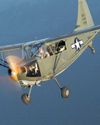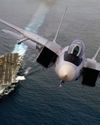कोशिश गोल्ड - मुक्त
Untold Story: How The USAF Won The Korean War But Couldn't Tell Anyone
Flight Journal
|December 2019
Not even the most aggressive aerial bombing in history was winning the Korean War, until one heroic Air Force mission did the impossible—ended the war—and violated every rule command leadership had created. Author Thomas McKelvey Cleaver reveals the secrets behind this daring mission.

Between June 27, 1950, when the first U.S. interdiction bombing mission of the Korean War was flown, and July 27, 1953, the last day of the war, the United States Air Force dropped more bombs on North Korea than were dropped in the entire Pacific theater in World War II. If the totals from the U.S. Navy’s bombing campaign are added in, more bombs were dropped on North Korea than were dropped on Germany in World War II.
The capital of Pyongyang was bombed into rubble over a three-day all-out campaign in the summer of 1952. The entire North Korean electric power-generating grid was also bombed into rubble, and then subjected to repeated bombing to keep it nonoperational for over a year. The agricultural water system was bombed and the country flooded in the spring of 1953. Every road, every railroad, and every bridge was bombed. As one Air Force planner put it, “If it was bigger than an outhouse, we bombed it.” All of this effort was undertaken to break the will of the North Koreans and their Chinese allies to continue the war. None of it worked. As VADM J.J. “Jocko” Clark, one-time commander of Task Force 77, and later commander of the U.S. Seventh Fleet during the final year of the war put it, “The aerial interdiction campaign didn’t interdict.”
यह कहानी Flight Journal के December 2019 संस्करण से ली गई है।
हजारों चुनिंदा प्रीमियम कहानियों और 10,000 से अधिक पत्रिकाओं और समाचार पत्रों तक पहुंचने के लिए मैगज़्टर गोल्ड की सदस्यता लें।
क्या आप पहले से ही ग्राहक हैं? साइन इन करें
Flight Journal से और कहानियाँ

Flight Journal
ELLIPTICAL ELEGANCE
Flying and evaluating the Seafire Mark III
4 mins
November - December 2025

Flight Journal
IRON DOG
Fighting the Pacific and the P-39 at the same time
14 mins
November - December 2025

Flight Journal
Fighter Pilots: A Warrior Clan
TAKE A HARD LOOK at the two young men in these photos. Do they look as if they were bent on killing one another? On the left we have a young, unknown enlisted Japanese pilot standing in front of a Nakajima Ki-27 \"Nate,\" one of Japan's earliest monoplanes that led to the much vaunted Zero.
3 mins
November - December 2025

Flight Journal
KEN WALSH THE FIRST CORSAIR ACE
Medal of Honor pilot's combat adventures
12 mins
November - December 2025

Flight Journal
Big Chief's Little Chief
Thunderbolt action with the Wolf Pack
11 mins
November - December 2025

Flight Journal
ENEMY PILOTS SPEAK Voices from the other side
All too often American students of air warfare forget that enemy aircraftwhether Messerschmitts or MiGs-were flown by human beings with the same motivations and traits as Allied airmen. More often than not, the only difference between friend and foe was the paint on the airplane and where they landed. Therefore, we've assembled a variety of accounts from WW II Axis fighter pilots, men who were more than simply targets.
11 mins
November - December 2025

Flight Journal
FLYING THE FW 190
A legend gets checked out in the Butcher Bird
15 mins
November - December 2025

Flight Journal
DOUBLE-THEATER ACE
The fearless missions of legendary fighter pilot Col. John D. Landers
12 mins
November - December 2025

Flight Journal
WARBUG IN THE PACIFIC
Surviving combat in a Stinson OY-1/L-5
10 mins
September - October 2025

Flight Journal
WINGS OF THE FLEET
Celebrating the U.S. Navy's 250-year legacy
9 mins
September - October 2025
Translate
Change font size

